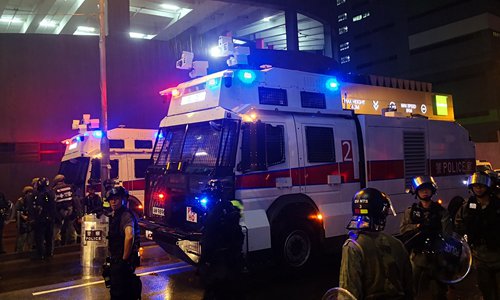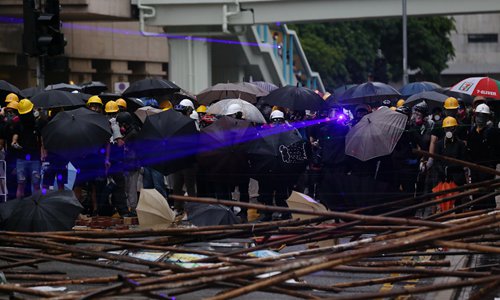HOME >> CHINA,SPECIAL-COVERAGE
Frontline HK officers confident in handling violence, condemn fake reporters
By Chen Qingqing, Fan Lingzhi and Wang Wenwen in Hong Kong Source:Global Times Published: 2019/8/31 10:07:18

Hong Kong police use water cannons to disperse illegal rallies for the first time on Sunday in Tsuen Wan. Water was fired toward barricades and the open space without targeting protesters. Photo: Cui Meng/GT

Protesters block roads and aim laser beams to provoke police officers during a protest on Sunday in Tsuen Wan, Hong Kong. Photo: Cui Meng/GT
Frontline law enforcement officers met with Chinese and Western reporters separately at Hong Kong Police Force headquarters on Friday before a banned rally on Saturday for the fifth anniversary of the National People's Congress landmark 831 Decision.
During the press conference, police officers explained they objected to the rally out of safety concerns. However, foreign reporters insisted on asking questions like "If protesters gather peacefully tomorrow, would the police take action?" and "Are you going to use the tear gas tomorrow?"
Since June, almost every protest has turned violent, placing the lives of Hong Kong residents in danger.
"If protesters violate the letter of objection and gather publicly tomorrow, it could be seen as a violation of the Public Order Ordinance. The police reserve the rights of law enforcement," said one frontline officer who requested that his name be withheld.
This was the answer foreign media expected.
"How do you define violence?" a foreign reporter asked.
The officer explained that when the protesters deviated from the approved demonstration routes and blocked roads which severely disrupted public order, the police have continued to show restraint, and have done so until confrontation has escalated. Authorities usually monitor the situation without taking further action.
In response, the foreign reporter said, "I don't think setting up barricades and blocking roads is violent."
Such claims provoked the police officer, who refuted them by saying that the radical protesters dismantled railings that had been set up along the roads and used iron rods to attack the police.
"One of my colleagues, whose chest was seriously injured as rioters stabbed him with an iron rod. Don't you call that violence?" the officer asked.
Escalating violence
The police banned Saturday's rally as intelligence found that radical protesters may carry out acts of violence as they had usd lethal weapons like Molotov cocktails, corrosive liquids, tobacco pads, and air force condors, said regional police commander Kwok Park-chung at a press conference on Friday.
According to Kwok, the demonstrators are capable of using staple guns and rifles and making powder explosives. Aerial camera technology could also play a role in assisting with ground assaults and therefore require police to use proportionate force.
"Such behavior brings tremendous danger, which could lead to causalities. To prevent dangerous situations, the police will use proportionate force to stop the violence," Kwok said.
In spite of multiple warnings from police, should protesters insist on illegally assembling on Saturday, authorities will enforce the law. However, when Western media and a few Hong Kong reporters targeted local police on brutality concerns, the same frontline officer asked the reporters to reflect on what has caused the violence to escalate.
"The police have been highly restrained," the officer said, noting how they have only reacted when attacked or provoked by the protesters.
Tactical upgrades
"As the deputy commander of the Quick Reaction Force, I reiterated that if protesters do not use force, the police will not use force," said a police officer surnamed Au, who is deputy commander of a Regional Response Contingent.
"From making road barricades, hurling bottles and bricks, throwing steel balls to hurling Molotov cocktails, they have provided many challenges to law enforcement," he said, adding that some protesters have brought children with them, which has made some situations more difficult to handle.
When asked what measures would the police take in dealing with surprise assaults, Au said they would deploy tactics based on received intelligence and they have prepared enough police personnel to handle such attacks in different regions.
Au told the Global Times that each time he would be very worried about the safety of his colleagues.
"Besides violence, the media would report our law enforcement from certain angles. My colleagues and their families have endured bullying, malicious personal attacks and online information leaks," Au said.
The violence has been ongoing for more than two months, and some of the police officers have grown tired; but after several days of action, they can better deploy units and have a better understanding of tactics. They are fully prepared for future operations, he explained.
Community support
A public relations officer surnamed Chan told the Global Times that violent activities have disturbed residents.
"My area has been hit 10 times since August 5. From some online video clips, it seems that residents support the rioters, but it is not the case," Chan said.
"Many residents have offered support for us and resent the protesters coming to our area," Chan said.
Chan also noted that the police received 600 letters demanding that they not issue a letter of no objection to the organizers of the August 11 protest, because they realized that most of the demonstrations in their area usually end in violence.
Chan also said the protests had affected local businesses, while some residents have had problems with going to sleep at night.
"They are the silent majority, but it doesn't mean they are not affected," Chan noted.
Chan said some residents provided police with intelligence on the whereabouts of the vehicles of protesters andwhat materials they had, which helped police remove concealed weapons based on the tips they received.
Fake reporters
Due to his identity, a mobile force officer felt that some of his friends who had different political views isolated him.
"They began to disrespect my profession and even verbally attack me," the officer said. "At first, I would explain to them what happened, which was futile."
The 23-year-old officer is the same age as many of the young protesters who see the violence as a "counter-strike" game. But to him, his duty is to eliminate violence and enforce the law.
"I will enforce law even the object is my friend because I believe I'm doing the right thing," he said.
On August 25, when the officer was conducting an operational task, someone wearing a press jacket approached him and his colleagues and said that someone was in need of assistance. After they were guided to the so-called person in need, they were attacked by dozens of rioters.
"We don't want to judge if the person with the press jacket is a real reporter or not, but it is a problem now in Hong Kong as who is a real reporter and who is not," Chan told the Global Times.
"It is possible that some protesters commit violence but his next move in front of the cameras suggested otherwise, which is despicable," Au noted, adding they cannot fix what is the truth, and their job now is to restore the rule of law in Hong Kong.
Posted in: SOCIETY,HK/MACAO/TAIWAN,FOCUS NEWS